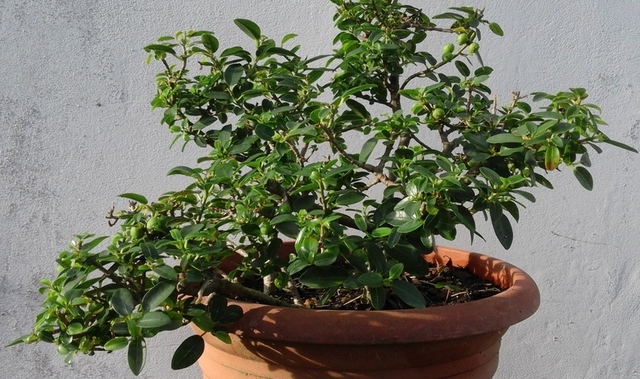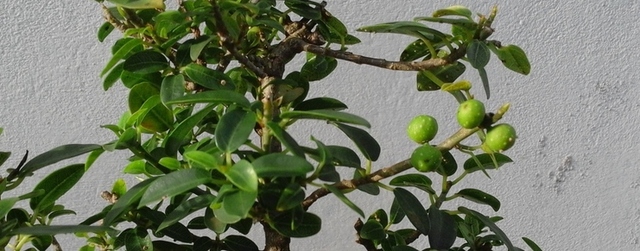Ficus Bonsai With Fruit
Using devious bonsai techniques, it is possible to miniaturise almost any part of a plant except for the flowers and fruit. No matter how small one can make the leaves, fruit and flowers always develop to the size of the fruit and flowers of a full-sized tree. The reason why flowers and fruit remain large is because they are reproductive organs, and we all know that when is comes to reproductive organs, bigger is better, so they say. Everything a plant does is related to the survival and longevity of itself and its offspring. Many small leaves are way more efficient than just a few large leaves, so the plant is encouraged to develop many small leaves, but small flowers attract fewer insects and therefore reduce the chances of a specific plant being fertilised. So, a plant will always produce full-sized flowers and fruit to increase the chances of it producing offspring.

If one pages through almost any book on bonsai that has large glossy photos, one inevitably comes across a bonsai citrus tree, normally an orange of some variety, that has a lovely shape and small leaves, with one or two seemingly gigantic oranges. Because everything else has been miniaturised the large fruit look somewhat outlandish and unnatural. The only way to reduce the unbalanced visual effect is to choose a variety that naturally has smaller fruit to begin with, but they will always appear too large for the rest of the tree. However, developing bonsai with fruit is not very high on most bonsai growers’ lists of priorities and a citrus bonsai with just one or two fruit is often grown simply for curiosity’s sake.
Although fruit on bonsai are not a goal of bonsai growers, flowers are. Specific species are grown purely for their ability to produce flowers. Azaleas are probably the most popular flowering species, closely followed by apricots and peaches, but these species are mostly found in Japan. Not many African tree species are renown for producing flowers, especially as bonsai, however, bougainvillea, although not indigenous to Africa, do very well as flowering bonsai in Southern Africa.
The image below shows some tiny fig fruit on some of my ficus cuttings. These cuttings are about 7 years old and are still in the pot that I first planted them into. Each fruit is about half the size of a peanut, but they still look too large for the tiny leaves. The official name for this ficus species is ficus burt davii nana kango – nana means it has small leaves, and kango is because the original plant was discovered near the Kango Caves in South Africa. As far as I know, this is the fig species that has the smallest leaves and is highly sought after because of that.

Below is a follow-up image of the fig that starred in my previous post of about three weeks ago. After removing most of the tree, leaving just one small shoot, the plant is growing well, with renewed vigor. The main shoot has doubled in size and has put out a new side branch lower down. Also, a whole bunch of new shoots have emerged from the base which gives me a number of styling options for later on. I might even remove the main shoot entirely and begin a small multi-trunked creation completely from scratch. Something else to note, is that as the new main shoot increases in size, the first set of leaves it puts out are relatively small, but the next set are a little bit larger, and the last set of leaves is even larger still. This is a pattern that is repeated in many species of tree. Simply by cutting the shoot after the first or second set of leaves we keep the leaves small, encouraging more side shoots and a bushy small tree. This is how bonsai are created.

producing a whole bunch of new shoots at the
base. This will give me a whole lot of styling
options when spring comes around once more.
And that is my lot for the moment. Till next time, keep growing. . . . Gary

